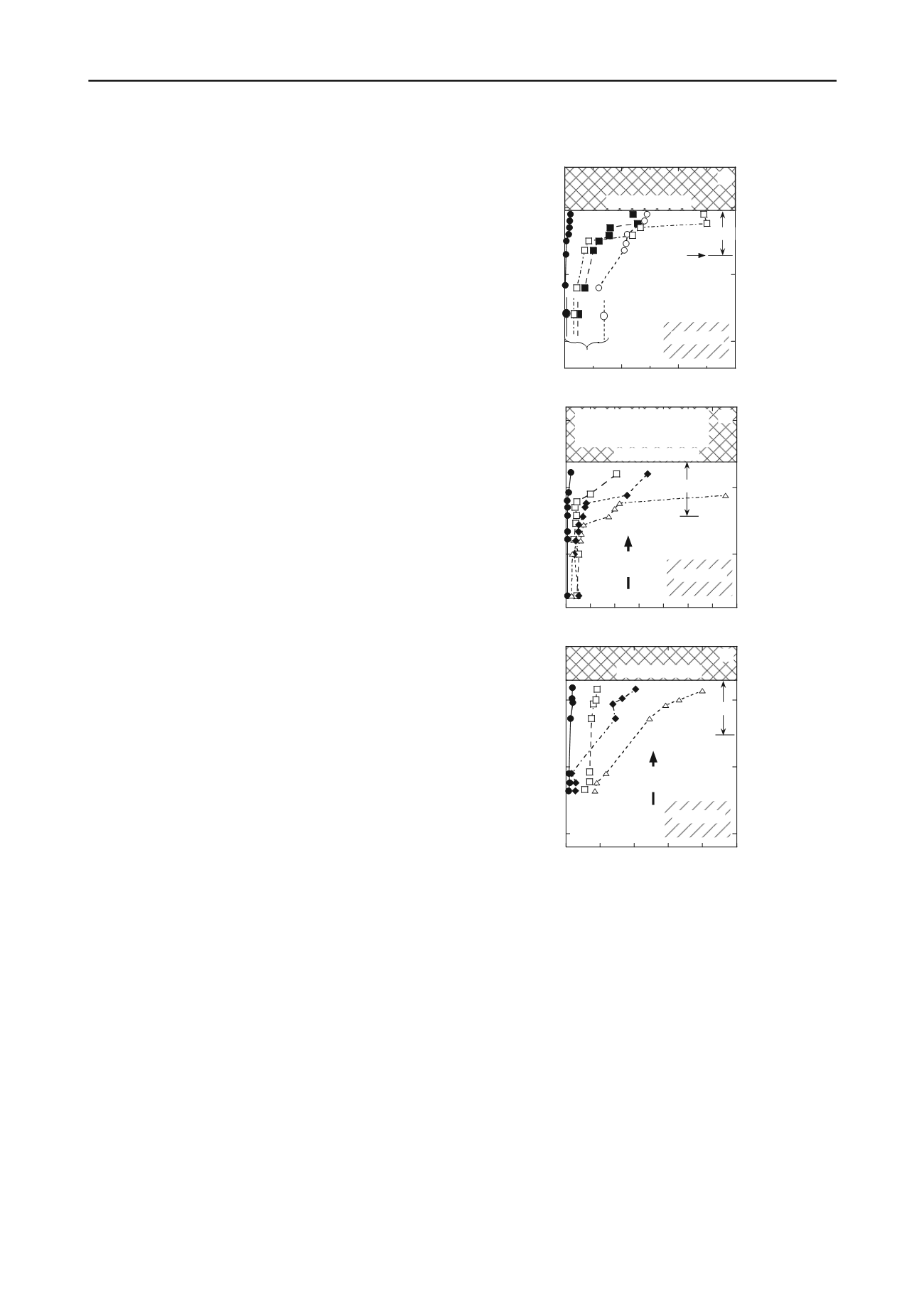
132
Proceedings of the 18
th
International Conference on Soil Mechanics and Geotechnical Engineering, Paris 2013
6
concentrations of the primary cations, i.e., K
+
, Na
+
, Ca
2+
and Mg
2+
were plotted as a function of depth beneath the
interface of the waste and the till, as shown in Fig. 4. The
k
h
of the silty clay till in the vicinity of the landfills was
measured using both laboratory and field methods over
depths ranging from 1.5 to 27.4 m, and 14 of the 18
measured
k
h
values were lower than 10
-10
m/s.
At the Confederation Road landfill site (Fig. 4a), the
landfill was located directly upon unfissured, intact, gray
clay below a desiccated crust, and piezometers indicated
downward seepage gradients that enabled, together with
measured values of
k
h
and
n
, calculating a maximum
advective front of 0.04 m over the 6-yr life of the landfill.
However, as shown in Fig. 4a, the measured disperse
cation front extended to a much greater distance of about
0.3 m, well beyond the advective front. The authors
recognized that advective migration in accordance with
Darcy's law could not be the primary transport process, and
that the cation concentration profiles resembled those that
would be predicted on the basis of diffusive dominated
conditions (e.g., compare Fig. 4a with Fig. 2d).
The same conclusions were drawn with respect to the
cation concentration profiles beneath the Blackwell Road
landfill, although the diffusive front had extended to an
even greater depth (0.4-0.8 m), despite the existence of
upward hydraulic gradients resulting from consolidation of
the underlying till due to loading by the overlying MSW.
In this case, the authors attributed the greater extent of
cation migration to the existence of fissures in the clay,
providing pathways for more rapid downward migration,
followed by diffusion of the cations into the surrounding
intact clay matrix resulting in the observed concentration
profiles. This latter process is referred to as "matrix
diffusion" and will be discussed in more detail later. A
subsequent study reported by Crooks and Quigley (1984)
involving additional field analyses and associated
laboratory testing confirmed the earlier conclusions drawn
by Goodall and Quigley (1984).
Another field study reported by Johnson et al. (1989)
involved obtaining vertical core samples from an
impervious, unweathered, water-saturated clay deposit
beneath a 5-yr-old hazardous waste landfill site in
southwestern Ontario, Canada. Sections of the cores were
analyzed for chloride and volatile organic compounds
(VOCs). Waste-derived chloride was detected in the clay
to a maximum depth of ~ 0.83 m below the bottom of the
landfill, whereas the most mobile VOCs were found to a
depth of only ~ 0.15 m. The authors concluded that the
downward transport of these chemical species was the
result of simple Fickian diffusion and, more importantly,
that the results of this study had important implications for
clay-lined waste disposal sites. Specifically, they noted that
for engineered clay liners of typical thickness of ~ 1 m,
simple diffusion could cause breakthrough of mobile
contaminants in approximately 5 yr, and that the diffusive
flux emanating from such liners could be large, at least
from the perspective of protection of human health and the
environment.
5.5
6
6.5
0
100
200
300
(a)
Depth (m)
Cation Concentration (mg/L)
Bottom of Landfill
0.3 m
Background
~ Extent of
Diffusive
Front
K
+
Na
+
Mg
2+
Ca
2+
Glacial Till
Glacial Till
2
2.5
3
0 100 200 300 400 500 600 700
(b)
Depth (m)
Cation Concentration (mg/L)
Rubber Boot, Plastic Bags,
Milk Cartons, Wire Fence,
Newspaper
Bottom of Landfill
0.4 m
Consolidation
Flow Gradient
~ Extent of
Diffusive Front
K
+
Na
+
Mg
2+
Ca
2+
2.5
3
3.5
0 100 200 300 400 500
(c)
Depth (m)
Cation Concentration (mg/L)
Bottom of Landfill
Consolidation
Flow Gradient
~ Extent of
Diffusive Front
0.4 m
K
+
Na
+
Mg
2+
Ca
2+
Glacial Till
Figure 4. Cation concentration profiles beneath two landfills at
Sarnia, Ontario, Canada: (a) Confederation Road landfill; (b)
Blackwell Road landfill, borehole 1; (c) Blackwell Road landfill,
borehole 3 (modified from Goodall & Quigley 1977).
As a result of these and other studies involving natural
clays (e.g., Barone et al. 1989, Barone et al. 1992, Myrand
et al. 1992, Sawatsky et al. 1997, Donahue et al. 1999,
Itakura et al. 2003, Mieszkowski 2003, Appelo et al. 2008,
Jakob et al. 2009), diffusion became recognized as an
important transport process in low permeability porous
media. This recognition led to studies focused on
evaluating the role that diffusion played in terms of
governing contaminant migration through engineered clay
barriers, such as CCLs. The results of several of these
studies are described in the following section.
4.2.2
Diffusion through Engineered Clay Barriers
Although several studies have focused directly on
evaluating the role of diffusion in governing contaminant
migration through engineered clay barriers, such as CCLs
used for MSW, HSW, and low-level radioactive waste
(LLRW) disposal as well as compacted bentonite buffers


